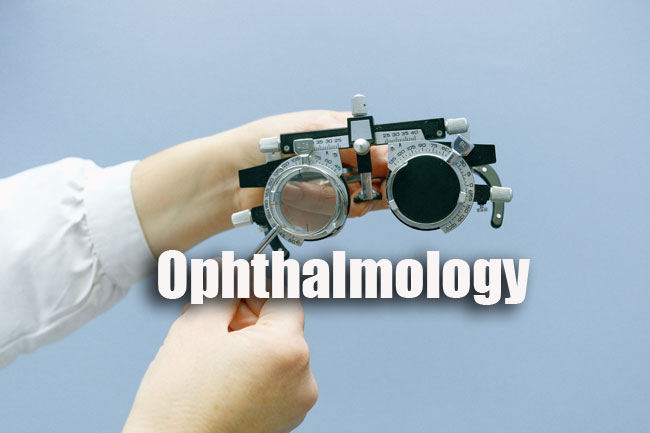Ophthalmology MCQ
Ophthalmology MCQ paper for the written examination is given below. Candidates who are looking for Ophthalmology exam MCQ paper can find in this section. The applied candidates who are getting prepared for the Ophthalmology can view this page for the Ophthalmology Last Ten Years MCQ Papers.

Download the Ophthalmology MCQ & Solutions & make it as a reference for your exam preparation. Take advantage of these Ophthalmology MCQ Papers in a proper manner to get qualifying Marks. Last 5 years Ophthalmology MCQ Papers provided here. Candidates who are applied for the above exam can check and download the Ophthalmology MCQ Papers from here.
MCQ on Ophthalmology
1. A 20 year old women with 3D sp both eye glasses with 6/6 vision underwent lasik surgery. On next day she had corneal haze on S/L and pain with blurred vision. What is most likely diagnosis.
1) Infection Keratitis
2) Diffuse lamellar Keratitis
3) Intestitial Keratitis
4) Disciform Keratitis
2. If any prostaglandin are added with timolol 0.5% drops. What amount of additive reduction of intraocular pressure is seen
1) 5 to 10%
2) 10 to 15%
3) 15 to 28%
4) 25 to 40 %
3. All are active VEGF agents EXCEPT
1) Bevacizumab
2) Ranibizumab
3) Verteprofin
4) Pegapatanib sodium
4. Malignant glaucoma is most likely seen postoperatively in
1) Myopic eyes
2) Hyperopic eyes
3) Aphakic eyes
4) Pseudophaki eyes
5. To get best changes in corneal shape and aberration free surface can be achieved by which technique of myopia
1) 1-LASIK
2) LASEK
3) femto second-LASIK
4) SMILE femto second
6. what is the drug of choice to treat post yag laser pressure spike
1) Timolol 0.5% BD
2) Levobunolol 0.5% BD
3) Apraclonidine 1% 0.5 BD
4) Brimonidine 0.2%BD
7. Moor field regression analysis on HRT shows assesment of
1) Field defects due to glaucoma
2) Neuro retinal rim and disc area in glaucoma cupping with normal data
3) Monitor progression in glaucoma
4) Peripapillary changes in glaucomma
8. Herbert’s pits are seen on
1) Lid margin
2) Pelpebral conjunctiva
3) Arlt’s Line
4) Limbus
9. Association of Keratoconjuctivitis sicca with Rheumatoid arthritis is
1) Reiter’s syndrome
2) Sjogren’s syndrome
3) Steven Johnson syndrome
4) Mikulicz’s syndrome
10. Hudson-stahli lines in cornea are
1) Red
2) Yellowish -red
3) Yellowish-brown
4) Yellow
11. Munson’s sign is seen in
1) Episcleritis
2) Chalcosis
3) Keratoconus
4) Retinal Detachment
12. Action of right Superior oblique muscle is
1) Laevodepression
2) Laevoelevation
3) Dextrodepression
4) Dextroelevation
13. Synkinetic ptosis is typically seen as
1) Bell’s phenomenon
2) Myasthenia Gravis
3) Marcus Gunn phenomenon
4) Maldevelopment of Levator muscle
14. Most common type of lid carcinome is
1) Adenocarcinome
2) Melanoma
3) Basal cell carcinoma
4) Symmetrical enlargement
15. Keratoconjuctivitis sicca refers to
1) Aqueous tear deficiency dry eye
2) Mucin deficiency dry eye
3) Lipid deficiency dry eye
4) All type of dry eyes
16. Normal pH of tear is
1) 5.7
2) 6.7
3) 7.5
4) 7.9
17. Crocodile tears are seen in
1) Frey’s syndrome
2) Conjuctivitis
3) Lacrimal tumour
4) Abnormal VII nerve regeration
18. Most common cranial nerve involve in ophthamologic migrane is
1) II nerve
2) III nerve
3) V nerve
4) VI nerve
19. Uncrossed diplopia is seen with
1) Esotropia
2) Exotropia
3) Esophoria
4) Exophoria
20. Principle of the stenopic slit is based on
1) Astigmatic fan
2) The circle of least diffusion
3) Pin-hole phenomenon
4) Sturm’s conoid
| Practice Set | MCQs |
| Quiz | Questions and Answers |
| Ophthalmic Surgery |
21. Diameter of fovea centralis is
1) 0.5 mm
2) 1 mm
3) 1.5 mm
4) 2.5 mm
22. The shortest extraocular muscle is
1) Superior oblique
2) Inferior oblique
3) Superior rectus
4) Inferior rectus
23. Acute haemorrhagic conjuctivitis is caused by
1) Entero virus
2) Adenovirus type 8
3) Picorna virus
4) Gonococcus
24. Snow ball’ opacities near ora serrata are pathognomic of
1) Fungal Endophthamitis
2) Pars-plantis
3) Diabetic retinopathy
4) Anterior chroiditis
25. All of the following are included invision 2020 goals except
1) Refractive errors
2) Glaucoma
3) Cataract
4) Childhood blindness
26. Treatment of Accomodative squint is
1) Accomodative I.O.L.
2) Surgery
3) Orthroptic exercise
4) Prism correction
27. All Lesions are seen in blunt trauma Except
1) Macular hole
2) Berlin’s edema
3) soft exudates
4) Angle recession
28. Optic neuritis is not seen in
1) Multiple sclerosis
2) Diabetes
3) Methenol poisioing
4) none
29. First sign of optic nerve disease is
1) colour blindness
2) Afferent pupillary defect
3) Efferent pupillary defect
4) Loss of accomodation
30. In Bupthalmos lens is
1) Small
2) Large
3) Anterioposterior flat
4) Normal
31. Most common systemetic association of scleritis is
1) Giant cell arteritis
2) Rheumatoid arthritis
3) Disseminated systemic sclerosis
4) Reiter’s syndrome
32. Image seen by ophthalmoscopy is
1) Inverted and virtual
2) Erect and Virtual
3) Inverted and real
4) Erect and real
33. Distance of lateral rectus from Limbus
1) 4.5mm
2) 5.5 mm
3) 7.0 mm
4) 9.0 mm
34. All are seen in 3rd nerve palsey
1) Mydriosis
2) Diplopia
3) Proptosis
4) Exodeviation
35. Blue sclera is seen with
1) Kawasaki syndrome
2) Kaposi sarcoma
3) Osteogenesis imperfecta
4) Giant cell arteritis
36. In terrian’s marginal degeneration following is seen
1) Epithelial defects
2) Painful red eye
3) Inferior thinning
4) Lipid deposition
37. Uveitis associated with trabeculitis is seen in
1) Fuchs heterochromic iridocyclitis
2) Bechet’s disease
3) Herpetic uveitis
4) sarcoidosis
38. Presenting sign of marfan’s syndrome in the eye is
1) pupillary block glaucoma
2) monocular diplopia
3) need for aphatic correction
4) Inferonasal subluxation
39. Ansler’s sign is seen in
1) Mucopurelent conjunctivitis
2) Eales disease
3) Fuch’s uveitis
4) Vogt’s Koyanagi Haradas syndrome
40. Critical period of development fixation reflax is
1) 2-4 months of age
2) 6-8 months of age
3) 2 years
4) 3 years
41. scleritis is most commonly associated with
1) Rheumatic Arthritis
2) Tuberculosis
3) P.A.N.
4) Toxoplasmosis
42. Healed patch of chorioretinitis give rise to
1) Absolute Seotoma
2) Positive seotoma
3) Slopping seotoma
4) Negative seotoma
43. Steroid responsiveness are present with
1) P.O.A.G.
2) High myopia
3) Diabetes
4) All of above
44. Most common fungal infection in AIDS patients
1) Candida
2) Cryptococus
3) Aspergillous
4) Fusarium
45. All are cause of Band keratopathy Except
1) Phthisis bulbi
2) Chronic cyclitis
3) Increase phosphorus level
4) Enteropian
46. Terrien marginol degenration Which is correct
1) Unilateral
2) Bilateral
3) Inferior Cornia Involve
4) Female are more prone
47. What is Dallen
1) Deposition of mucous of cornea
2) Localised area of corneal thinning
3) Raised limbal lesion
4) Deposition of epithelium
48. VER is useful in diagnosis of all the following EXCEPT
1) Retinitis Pigmentosa
2) Optic Atropy
3) Visual potential in eye with opeque media
4) Retrobulbar neuritis
49. Most Common cause of Posterior staphyloma
1) Trauma
2) Glaucoma
3) Myopia
4) Scleritis
50. The most reliable provocative test for angle closure glaucoma
1) Dark room test
2) Mydriatic test
3) Miotic test
4) water drinking test



